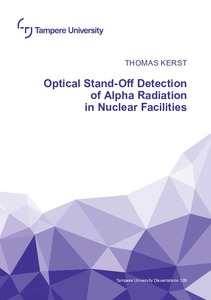Optical Stand-Off Detection of Alpha Radiation in Nuclear Facilities
Kerst, Thomas (2019)
Kerst, Thomas
Tampere University
2019
Tekniikan ja luonnontieteiden tohtoriohjelma - Doctoral Programme in Engineering and Natural Sciences
Tekniikan ja luonnontieteiden tiedekunta - Faculty of Engineering and Natural Sciences
This publication is copyrighted. You may download, display and print it for Your own personal use. Commercial use is prohibited.
Väitöspäivä
2019-10-04
Julkaisun pysyvä osoite on
https://urn.fi/URN:ISBN:978-952-03-1247-3
https://urn.fi/URN:ISBN:978-952-03-1247-3
Tiivistelmä
Numerous nuclear power plants will soon reach the end of their lifetime and must be decommissioned. The number of upcoming decommissioning projects is unprecedented and new technologies are needed to rapidly and reliably identify radioactive contamination. Remote detection of alpha radiation by optical means is one of those new technologies. It collects the ultraviolet (UV) scintillation of nitrogen molecules (N2) in air, the radioluminescence, to reveal the presence of alpha emitters.
This Thesis summarises the advances of the technology since its first conception and demonstrates its efficacy by remotely detecting alpha contamination in a nuclear research facility. It shows that alpha imaging requires the absence of daylight and that this limitation, together with lower-than-required sensitivity levels, make the technology mostly untenable for use in decommissioning tasks. Radioluminescence of nitric oxide (NO) is presented as a means to improve the sensitivity levels. It is shown that replacing the air around an alpha emitter with a mixture of 50ppm of NO in N2 amplifies the production of ultraviolet light by more than two orders of magnitude. The technique is shown to render the detection resistant to influences of daylight.
A theory is developed that provides an explanation for the production of NO radioluminescence. The theory hypothesises that a specific form of fluorescence quenching and unique access to a reservoir of energy account for much of the light production. It is shown to correctly predict the conditions under which a N2 purge can create NO radioluminescence in otherwise ambient air.
A fully resolved spectrum of the radioluminescence in water is presented. The origins of the radioluminescence are discussed and its utility for the remote detection of alpha radiation in liquids is highlighted.
The Thesis outlines techniques that enable optical alpha detection to overcome both the daylight and the sensitivity problem. Limitations that keep the technology from finding widespread use in decommissioning tasks are directly addressed. The theory can be used to further enhance radioluminescence intensity.
This Thesis summarises the advances of the technology since its first conception and demonstrates its efficacy by remotely detecting alpha contamination in a nuclear research facility. It shows that alpha imaging requires the absence of daylight and that this limitation, together with lower-than-required sensitivity levels, make the technology mostly untenable for use in decommissioning tasks. Radioluminescence of nitric oxide (NO) is presented as a means to improve the sensitivity levels. It is shown that replacing the air around an alpha emitter with a mixture of 50ppm of NO in N2 amplifies the production of ultraviolet light by more than two orders of magnitude. The technique is shown to render the detection resistant to influences of daylight.
A theory is developed that provides an explanation for the production of NO radioluminescence. The theory hypothesises that a specific form of fluorescence quenching and unique access to a reservoir of energy account for much of the light production. It is shown to correctly predict the conditions under which a N2 purge can create NO radioluminescence in otherwise ambient air.
A fully resolved spectrum of the radioluminescence in water is presented. The origins of the radioluminescence are discussed and its utility for the remote detection of alpha radiation in liquids is highlighted.
The Thesis outlines techniques that enable optical alpha detection to overcome both the daylight and the sensitivity problem. Limitations that keep the technology from finding widespread use in decommissioning tasks are directly addressed. The theory can be used to further enhance radioluminescence intensity.
Kokoelmat
- Väitöskirjat [4769]
